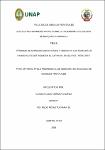Pérdidas de servicios ambientales y origen de las especies de palmeras registradas en el carnaval en Iquitos-Perú-2018
Abstract
El estudio se desarrolló en el casco urbano de la ciudad de Iquitos, ubicado en la provincia de Maynas, departamento de Loreto, República de Perú; con el objetivo de determinar la pérdida de servicios ambientales y el origen de las especies de palmeras registradas en el carnaval de Iquitos del año 2018. Se utilizó encuestas en los puntos de acopio para determinar el origen de las especies. Se midió el diámetro a la altura de pecho (DAP) y la altura de fuste. Para calcular la biomasa aérea y el carbono se aplicaron ecuaciones alométricas y posteriormente el CO2. Se identificaron 130 individuos y 4 especies procedentes de 15 comunidades; donde la especie Iriartea deltoidea es la más representativa y utilizada con el 70% del total de individuos, con 2,48 t biomasa, 1,24 t C y 4,55 t CO2, Euterpe precatoria que representa el 25% del total de individuos, con 1,06 t biomasa, 0,53 t C y 1,94 t CO2, reportando las mayores pérdidas, mientras que Socratea exorrhiza representa el 3% del total de individuos, 0.17 t biomasa, 0,08 t C y 0,30 t CO2 y por último Oenocarpus mapora que representa el 2% del total de individuos, 0,45 t biomasa, 0,22 t C y 0,82 t CO2, representando pérdidas bajas. Se acepta la hipótesis alterna donde la pérdida de servicios ambientales varía con el tipo de especies de palmera. The study was developed in the urban area of the Iquitos city, located in the Maynas province, Loreto department, Republic of Peru; with the objective of determining the loss of environmental services and the origin of the palms species registered at the carnaval festival in the of Iquitos city in 2018. Surveys were used at the collection points to determine the origin of the species. Diameter at breast height (DBH) and stem height were measure.To calculate the aboveground biomass and carbon allometric equations were applied and then CO2. 130 individuals and 4 species from 15 communities were identified; where the Iriartea deltoidea species is the most representative and used with 70% of the total individuals, 2.48 t biomass, 1.24 t C and 4.55 t CO2, Euterpe precatoria representing 25% of the total individuals, 1,06 t biomass, 0.53 t C and 1.94 t CO2, reporting the highest losses, while Socratea exorrhiza represent 3% of total individuals, 0.17 t biomass, 0.08 t C and 0.30 t CO2 and by Last Oenocarpus mapora, which represents 2% of the total individuals, 0.45 t biomass, 0.22 t C and 0.82 t CO2, representing low losses. The alternative hypothesis is accepted where the loss of environmental services varies with the type of palm species.
Collections
- Tesis [407]
The following license files are associated with this item:


